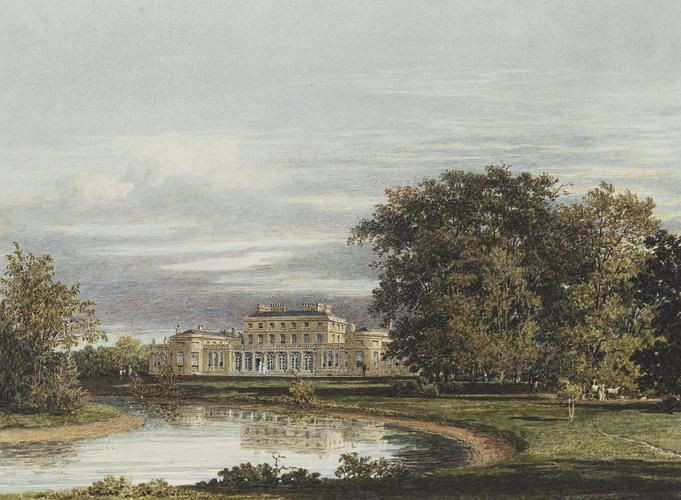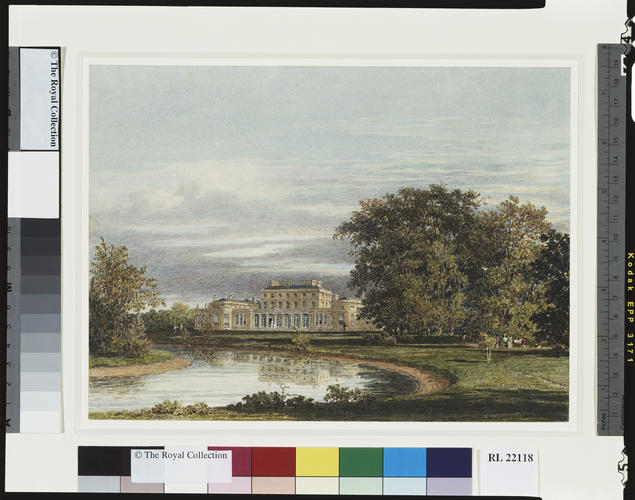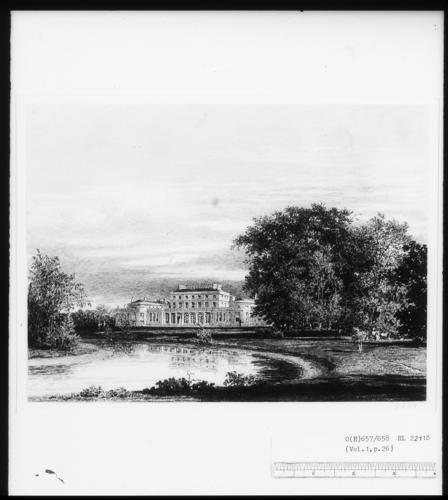Charles Wild (1781-1835)
Frogmore House: The garden front c. 1819
Watercolour and bodycolour over pencil | 18.4 x 24.9 cm (sheet of paper) | RCIN 922118
-
A watercolour view of the exterior of Frogmore House seen from the pond garden, depicting the central block with bay wings linked by colonnade facade with some figures standing on the driveway. Prepared for one of the plates in William Henry Pyne's History of the Royal Residences (1816-1819). Engraved by W. J. Bennett, the print published 1.8.1819.
Pyne's History of the Royal Residences was a three-volume publication which encompassed a number of royal residences, including Windsor Castle (vol. 1) and Buckingham House (vol. 2), presenting 100 hand-coloured engravings of exteriors and interiors accompanied by descriptive texts. The 100 watercolours which were engraved for the publication survive in the Royal Library; these watercolours are exactly the size of the image on the printed plates, and may perhaps have been intended as colour guides for the artists responsible for hand-painting the monochrome prints.
Catalogue entry adapted from George III & Queen Charlotte: Patronage, Collecting and Court Taste (London, 2004):
Frogmore House occupies its own small estate less than a mile to the south of Windsor Castle. It was not part of the medieval parkland surrounding the castle and until 1848 it was not part of the royal domain, but was held by private individuals via a series of crown leases. However, its proximity to the castle - and its seclusion - meant that it held an obvious attraction for the royal family and in 1792 the lease was acquired for the Queen by her friend General (later 3rd Earl) Harcourt. Two years earlier the lease of the smaller estate to the north - Little Frogmore - had also been acquired for the Queen. The two were now thrown together and work soon began on landscaping the grounds. The garden was always one of the chief attractions of Frogmore and much time was spent by the royal ladies ‘botanising’ there.
The core of the building is the seven-bay house built c.1680, probably to the designs of Hugh May. The entrance front faced north-east and the garden front (shown here) south-west. Work on the house was entrusted to James Wyatt but his name does not appear in any of the surviving accounts, and it was claimed that he received no payment for his services. In July 1793 Queen Charlotte wrote from Frogmore ( ‘my sweet temple’) to inform her Treasurer that ‘Mr Wyatt is just returned . . . with many pretty tantalizing proposals about my little paradise, of which many must be rejected, but not all . . . now the finishing of the rooms is to be settled, and some must be adopted for particular purposes, some alterations must take place, and as I am not at all eager to finish at once but can wait with patience’.
Most of the building work was carried out between June 1793 and late 1795, with further work in 1801 and 1804. By May 1795 single-storey pavilions linked by an open colonnade had been added to the garden front. Further additions were made, to left and right, in 1804 when a pair of two-storeyed bowed extensions and matching single-storey rooms were added to the garden front. Inside the house doorcases, window frames and chimneypieces were replaced with crisp neo-classical models, and the staircase was rebuilt.
In 1793 Queen Charlotte had written, ‘I mean this place to furnish me with fresh amusements every day’. Although the Queen and her daughters passed long periods at Frogmore - painting, botanising, music-making or reading - they never passed a night there. Numerous guests were entertained at Frogmore, particularly at the fêtes held in the garden.
On 23 December 1818, five weeks after her death, the Queen’s most intimate possessions were laid out at Frogmore so that her four youngest daughters could reserve what they wished prior to the auction. The house itself was bequeathed to Princess Augusta, who moved in after her father’s death in 1820.
The publication dates of Pyne’s views of Frogmore range from June 1817 to August 1819 - by which time the Queen had been dead for nine months, and the contents had been sold at auction. The views were clearly prepared some time before their publication.
Provenance
Probably acquired by George IV
-
Creator(s)
Acquirer(s)
-
Medium and techniques
Watercolour and bodycolour over pencil
Measurements
18.4 x 24.9 cm (sheet of paper)
Other number(s)
RL 22118











